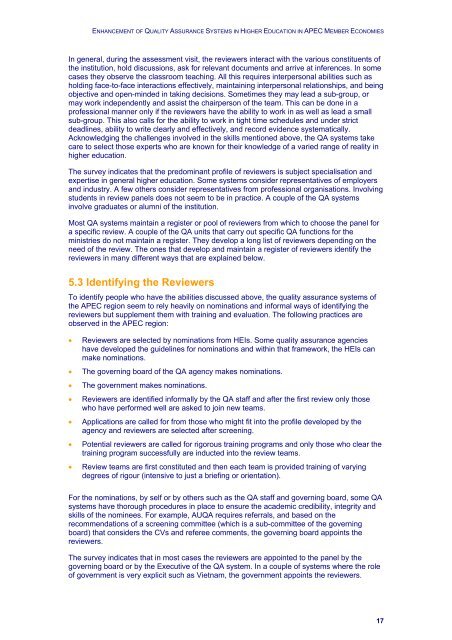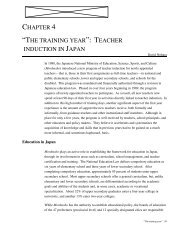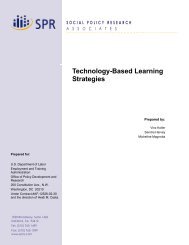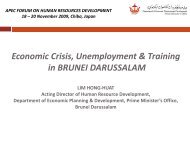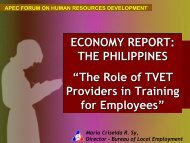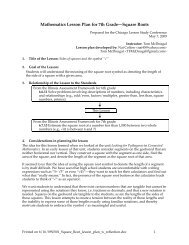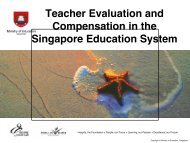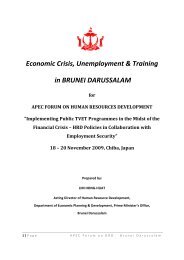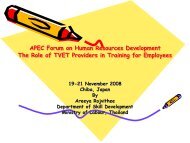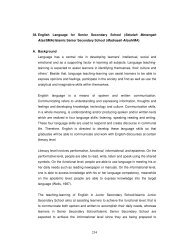Quality Assurance Systems in Asia-Pacific Economic Cooperation
Quality Assurance Systems in Asia-Pacific Economic Cooperation
Quality Assurance Systems in Asia-Pacific Economic Cooperation
You also want an ePaper? Increase the reach of your titles
YUMPU automatically turns print PDFs into web optimized ePapers that Google loves.
ENHANCEMENT OF QUALITY ASSURANCE SYSTEMS IN HIGHER EDUCATION IN APEC MEMBER ECONOMIES<br />
In general, dur<strong>in</strong>g the assessment visit, the reviewers <strong>in</strong>teract with the various constituents of<br />
the <strong>in</strong>stitution, hold discussions, ask for relevant documents and arrive at <strong>in</strong>ferences. In some<br />
cases they observe the classroom teach<strong>in</strong>g. All this requires <strong>in</strong>terpersonal abilities such as<br />
hold<strong>in</strong>g face-to-face <strong>in</strong>teractions effectively, ma<strong>in</strong>ta<strong>in</strong><strong>in</strong>g <strong>in</strong>terpersonal relationships, and be<strong>in</strong>g<br />
objective and open-m<strong>in</strong>ded <strong>in</strong> tak<strong>in</strong>g decisions. Sometimes they may lead a sub-group, or<br />
may work <strong>in</strong>dependently and assist the chairperson of the team. This can be done <strong>in</strong> a<br />
professional manner only if the reviewers have the ability to work <strong>in</strong> as well as lead a small<br />
sub-group. This also calls for the ability to work <strong>in</strong> tight time schedules and under strict<br />
deadl<strong>in</strong>es, ability to write clearly and effectively, and record evidence systematically.<br />
Acknowledg<strong>in</strong>g the challenges <strong>in</strong>volved <strong>in</strong> the skills mentioned above, the QA systems take<br />
care to select those experts who are known for their knowledge of a varied range of reality <strong>in</strong><br />
higher education.<br />
The survey <strong>in</strong>dicates that the predom<strong>in</strong>ant profile of reviewers is subject specialisation and<br />
expertise <strong>in</strong> general higher education. Some systems consider representatives of employers<br />
and <strong>in</strong>dustry. A few others consider representatives from professional organisations. Involv<strong>in</strong>g<br />
students <strong>in</strong> review panels does not seem to be <strong>in</strong> practice. A couple of the QA systems<br />
<strong>in</strong>volve graduates or alumni of the <strong>in</strong>stitution.<br />
Most QA systems ma<strong>in</strong>ta<strong>in</strong> a register or pool of reviewers from which to choose the panel for<br />
a specific review. A couple of the QA units that carry out specific QA functions for the<br />
m<strong>in</strong>istries do not ma<strong>in</strong>ta<strong>in</strong> a register. They develop a long list of reviewers depend<strong>in</strong>g on the<br />
need of the review. The ones that develop and ma<strong>in</strong>ta<strong>in</strong> a register of reviewers identify the<br />
reviewers <strong>in</strong> many different ways that are expla<strong>in</strong>ed below.<br />
5.3 Identify<strong>in</strong>g the Reviewers<br />
To identify people who have the abilities discussed above, the quality assurance systems of<br />
the APEC region seem to rely heavily on nom<strong>in</strong>ations and <strong>in</strong>formal ways of identify<strong>in</strong>g the<br />
reviewers but supplement them with tra<strong>in</strong><strong>in</strong>g and evaluation. The follow<strong>in</strong>g practices are<br />
observed <strong>in</strong> the APEC region:<br />
<br />
<br />
<br />
<br />
<br />
<br />
<br />
Reviewers are selected by nom<strong>in</strong>ations from HEIs. Some quality assurance agencies<br />
have developed the guidel<strong>in</strong>es for nom<strong>in</strong>ations and with<strong>in</strong> that framework, the HEIs can<br />
make nom<strong>in</strong>ations.<br />
The govern<strong>in</strong>g board of the QA agency makes nom<strong>in</strong>ations.<br />
The government makes nom<strong>in</strong>ations.<br />
Reviewers are identified <strong>in</strong>formally by the QA staff and after the first review only those<br />
who have performed well are asked to jo<strong>in</strong> new teams.<br />
Applications are called for from those who might fit <strong>in</strong>to the profile developed by the<br />
agency and reviewers are selected after screen<strong>in</strong>g.<br />
Potential reviewers are called for rigorous tra<strong>in</strong><strong>in</strong>g programs and only those who clear the<br />
tra<strong>in</strong><strong>in</strong>g program successfully are <strong>in</strong>ducted <strong>in</strong>to the review teams.<br />
Review teams are first constituted and then each team is provided tra<strong>in</strong><strong>in</strong>g of vary<strong>in</strong>g<br />
degrees of rigour (<strong>in</strong>tensive to just a brief<strong>in</strong>g or orientation).<br />
For the nom<strong>in</strong>ations, by self or by others such as the QA staff and govern<strong>in</strong>g board, some QA<br />
systems have thorough procedures <strong>in</strong> place to ensure the academic credibility, <strong>in</strong>tegrity and<br />
skills of the nom<strong>in</strong>ees. For example, AUQA requires referrals, and based on the<br />
recommendations of a screen<strong>in</strong>g committee (which is a sub-committee of the govern<strong>in</strong>g<br />
board) that considers the CVs and referee comments, the govern<strong>in</strong>g board appo<strong>in</strong>ts the<br />
reviewers.<br />
The survey <strong>in</strong>dicates that <strong>in</strong> most cases the reviewers are appo<strong>in</strong>ted to the panel by the<br />
govern<strong>in</strong>g board or by the Executive of the QA system. In a couple of systems where the role<br />
of government is very explicit such as Vietnam, the government appo<strong>in</strong>ts the reviewers.<br />
17


